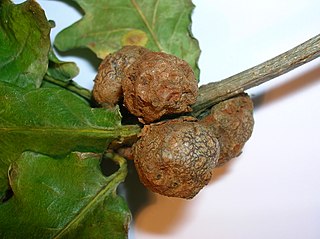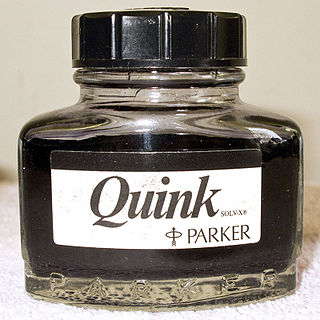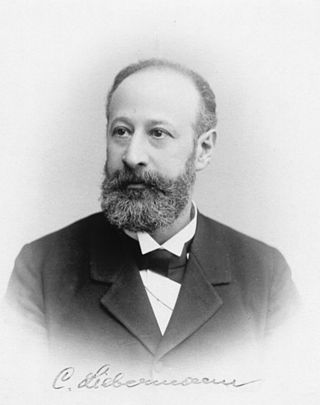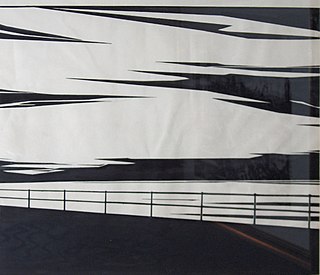Related Research Articles

Black is a color that results from the absence or complete absorption of visible light. It is an achromatic color, without hue, like white and grey. It is often used symbolically or figuratively to represent darkness. Black and white have often been used to describe opposites such as good and evil, the Dark Ages versus Age of Enlightenment, and night versus day. Since the Middle Ages, black has been the symbolic color of solemnity and authority, and for this reason it is still commonly worn by judges and magistrates.

Ink is a gel, sol, or solution that contains at least one colorant, such as a dye or pigment, and is used to color a surface to produce an image, text, or design. Ink is used for drawing or writing with a pen, brush, reed pen, or quill. Thicker inks, in paste form, are used extensively in letterpress and lithographic printing.

Invisible ink, also known as security ink or sympathetic ink, is a substance used for writing, which is invisible either on application or soon thereafter, and can later be made visible by some means, such as heat or ultraviolet light. Invisible ink is one form of steganography.

Galls or cecidia are a kind of swelling growth on the external tissues of plants. Plant galls are abnormal outgrowths of plant tissues, similar to benign tumors or warts in animals. They can be caused by various parasites, from viruses, fungi and bacteria, to other plants, insects and mites. Plant galls are often highly organized structures so that the cause of the gall can often be determined without the actual agent being identified. This applies particularly to insect and mite plant galls. The study of plant galls is known as cecidology.

Alizarin is an organic compound with formula C
14H
8O
4 that has been used throughout history as a red dye, principally for dyeing textile fabrics. Historically it was derived from the roots of plants of the madder genus. In 1869, it became the first natural dye to be produced synthetically.

A dip pen is a writing instrument used to apply ink to paper. It usually consists of a metal nib with a central slit that acts as a capillary channel like those of fountain pen nibs, mounted in a handle or holder, often made of wood. Other materials can be used for the holder, including bone, metal and plastic; some pens are made entirely of glass.

Gallic acid (also known as 3,4,5-trihydroxybenzoic acid) is a trihydroxybenzoic acid with the formula C6H2(OH)3CO2H. It is classified as a phenolic acid. It is found in gallnuts, sumac, witch hazel, tea leaves, oak bark, and other plants. It is a white solid, although samples are typically brown owing to partial oxidation. Salts and esters of gallic acid are termed "gallates".
Stark's ink is one of a number of types of homemade inks whose recipes were widely available in the 19th century. People often made their own ink before commercially available ink was inexpensively and easily obtainable. James Stark was a chemist during the 19th century who experimented with ink recipes for 23 years. He tested 229 recipes for their durability on various kinds of paper to find the most stable iron gall ink recipe. He submitted his findings in 1855 to the Society of Arts in Edinburgh, Scotland. This recipe was the one he personally used.

Iron gall ink is a purple-black or brown-black ink made from iron salts and tannic acids from vegetable sources. It was the standard ink formulation used in Europe for the 1400-year period between the 5th and 19th centuries, remained in widespread use well into the 20th century, and is still sold today.

John Christopher Gall is an American former Major League Baseball left fielder who played for the St. Louis Cardinals and Florida Marlins from 2005 to 2007.

An oak apple or oak gall is a large, round, vaguely apple-like gall commonly found on many species of oak. Oak apples range in size from 2 to 4 centimetres in diameter and are caused by chemicals injected by the larva of certain kinds of gall wasp in the family Cynipidae.

Fountain pen ink is a water-based ink intended for use with fountain pens.

Henry Edward Schunck, also known as Edward von Schunck, was a British chemist who did much work with dyes.

Rose madder is a red paint made from the pigment madder lake, a traditional lake pigment extracted from the common madder plant Rubia tinctorum.

Carl Theodore Liebermann was a German chemist and student of Adolf von Baeyer.

Andricus kollari, also known as the marble gall wasp, is a parthenogenetic species of wasp which causes the formation of marble galls on oak trees. Synonyms for the species include Cynips kollari, Andricus quercusgemmae, A. minor, A. indigenus and A. circulans.

India ink is a simple black or coloured ink once widely used for writing and printing and now more commonly used for drawing and outlining, especially when inking comic books and comic strips. India ink is also used in medical applications.

Alizarin crimson is a shade of red that is biased slightly more towards purple than towards orange on the color wheel and has a blue undertone. It is named after the organic dye alizarin, found in the madder plant, and the related synthetic lake pigment alizarin crimson. William Henry Perkin had co-discovered a way to synthesize the pigment alizarin, which became known as the color alizarin crimson. Its consistency and lightfastness quickly made it a favourite red pigment for artists.

Rubia tinctorum, the rose madder or common madder or dyer's madder, is a herbaceous perennial plant species belonging to the bedstraw and coffee family Rubiaceae.
References
- ↑ "David N. Carvalho, Forty Centuries of Ink". Archived from the original on 2003-06-26. Retrieved 2006-04-19.